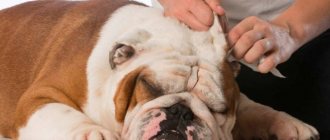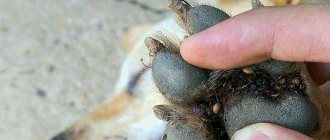Postoperative fistula, or fistula, in a dog is a serious complication that can be fatal. This tubular canal develops not only after surgery, but also in other situations that lead to an inflammatory process.
Owners of four-legged pets often confuse this pathological formation with an abscess (abscess), which requires a completely different method of treatment. For this reason, it is important to understand the main differences between these concepts and separate their symptoms, allowing you to diagnose a dangerous formation soon after its appearance.
Features of a fistula and its difference from an abscess/abscess
The main difference between a fistula and an abscess is the absence of a protective capsule that prevents pus from entering adjacent tissues and the formation of a tubule. Thanks to the channel, pyogenic bacteria move freely between organs or come out. Because of this, the method of treatment is also different.
Without timely opening, the abscess turns into phlegmon - extensive purulent inflammation without boundaries. To avoid complications, the capsule is opened surgically, but sometimes it bursts on its own. In this case, its tissues quickly scar and heal.
The walls of the fistula opening, covered with epithelium or connective tissue, are smooth and even. Such a wound does not heal and constantly oozes pus, so a secondary infection can easily get inside it. Cleaning and suturing the canal alone is not enough; to eliminate the problem, you will need to find its cause.
Postoperative
Fistulas that appear in a dog after sterilization are called ligature, or postoperative. They occur in the suture area as a result of the entry of pyogenic bacteria into a wound that has not yet healed. The owner is not always to blame here - in most cases, inflammation begins due to poorly processed suture material.
Other types
In addition to insufficient sterilization of the surgeon's instruments, the most common causes of inflammation in four-legged pets include arthritis, foreign object penetration, and blockage of the anal glands. In these cases, a pathological channel is formed in the following areas of the body:
- Limbs and ears
. The inflammatory process is provoked by sharp blades of grass that get under the skin. A fistula in a dog’s paw can also occur with an advanced infectious form of arthritis that occurs when infected with streptococci and staphylococci. The risk group includes breeds prone to dysplasia and those with short legs.
- Muzzle
. The pathology develops against the background of dental diseases, so most often the canal goes into one of the cheeks.
- Glands
located on both sides of the anus. Such a fistula in a dog is called paraanal or rectal. It occurs when a special secretion accumulates, serving as a natural lubricant during bowel movements.
The appearance of the fistula opening depends on the location of the canal exit. Those located inside are the most dangerous. They cannot be visually diagnosed, but, like external ones, they are accompanied by corresponding symptoms.
What does a fistula look like in a dog + associated symptoms
As a result of suppuration, a small compaction develops on the animal’s body. After a few days, it opens and the accumulated exudate begins to flow out. Absolutely smooth edges of the wound that appears prevent it from tightening. Dermatitis forms on adjacent tissues that become wet from constantly flowing pus.
Additional symptoms of the pathology include:
- soreness and baldness of the skin at the site of formation of the tubercles;
- a sharp putrid odor from an opening in the skin or mucous membrane;
- frequent licking of the affected area;
- fever, poor appetite and increased thirst in the event of a secondary infection;
- riding on the butt in rectal view;
- swelling and lameness characteristic of foreign object injuries and arthritis.
If with an abscess fever and chills are the main symptoms, then with a fistula they are practically not observed. In such situations, owners notice internal fistulas only after complications appear that expand the existing symptoms.
Causes
Due to their occurrence, formations are divided into congenital and acquired. The former appear in puppies in the womb due to various disorders, and the latter develop throughout life as a result of exposure to external and internal factors.
The appearance of acquired fistulas is associated with the following reasons:
- violation of aseptic rules during surgery or the use of too dense suture material;
- mechanical damage;
- arthritis and arthrosis;
- inflammation of the gums and tooth roots;
- blockage of the anal glands.
Congenital anomalies are very rare. Puppies with this diagnosis often die soon after birth. If the pathology appears, first of all they try to save the mother, since the exudate goes directly into her uterus.
Cleaning the anal glands at home
Doctors recommend regularly cleaning the anal glands in dogs. It is their blockage that is a common cause of fistula. If the owner has experience in providing medical care, then he can do it himself. You will need to muzzle your dog, even if it has never bitten before. The fact is that if a fistula develops in the anal area, then when pressure is applied the animal will feel pain.
So, how are the anal glands properly cleaned? To do this, you will need to take a swab and soak it in hydrogen peroxide. Afterwards, begin to massage the glands, pressing a little. If you do everything correctly, a dark liquid with a very pungent odor should spray out of them. After this, you should examine the anus. If there are inflamed areas on it, then it is advisable to lubricate them with Levomekol ointment.
What should the owner do?
If alarming symptoms appear, you should contact your veterinarian as soon as possible. If this is not possible, then you need to provide first aid to your pet:
- Treat the resulting hole with chlorhexidine solution. Do not use peroxide and iodine: the alcohol they contain will increase the pain and leave a burn, aggravating the inflammation.
- Inject levomekol ointment into the canal with a 2-cc syringe and treat the adjacent tissue. Do not use Vishnevsky ointment or syntomycin ointment - due to their greasy texture, they quickly clog the passage, disrupting the outflow of purulent exudate.
The treatment is aimed at temporarily relieving the consequences. The main treatment for fistulas in dogs involves eliminating the causes that caused them.
Contacting a veterinarian
If possible, do not use medications before contacting a veterinarian. They blur the symptoms and complicate the diagnosis.
After examining and determining the cause of the inflammation, the veterinarian may recommend the following options to eliminate it:
- repeated surgery to replace old suture material;
- excision of stuck foreign objects;
- use of antibiotics for infectious forms of arthritis;
- treatment or removal of problem teeth;
- cleansing or resection of the paraanal glands.
Symptomatic therapy is prescribed individually and may include analgesics, anti-inflammatory, antipyretic and antihistamines. The fistula canal is cleaned of pus and sutured. To prevent re-infection, the four-legged patient is prescribed broad-spectrum antibiotics. The duration of antibiotic therapy is individual. On average it is 5-14 days.
Procedures at home
After the operation, the animal is put on a protective blanket or collar. They prevent licking and scratching of the postoperative wound, facilitating its healing.
Due to the use of anesthesia, the pet will be disoriented for about 2 days. These days it needs to be placed in a warm and safe place on the floor. Attempts to climb onto a sofa or bed should be stopped, as the dog may suffer due to poor coordination. Also, for a comfortable recovery, you will need to follow a gentle diet, which involves frequent feeding in small portions.
Keep the seam clean and do not use products not approved by your veterinarian to treat it. The abundance of ointments reduces the rate of regeneration, so avoid excessive wetting of the skin and keep it dry.
To reduce postoperative swelling and destroy existing microorganisms, it is recommended to use quartz treatment and UHF therapy. You can sign up for these procedures at a veterinary clinic or carry them out directly at home by purchasing the necessary equipment. The second option is suitable for shy pets who cannot tolerate frequent visits to doctors.
What is not recommended to do when caring for seams?
For two weeks, the dog is not allowed off the leash during walks. If the pet feels free, overly energetic behavior will provoke the opening of a postoperative wound.
- Don't let other animals play with your dog.
- Do not allow your pet to jump or make sudden movements.
- In the postoperative period, do not bathe the animal or wet the sore spot with water.
- It is unacceptable to treat the skin with the use of creams, cosmetic and medicinal, to slow down healing.
When performing maintenance, especially with a torn seam, ensure cleanliness. If the postoperative area is heavily contaminated, it is permissible to treat it with hypertonic sodium chloride solution. There are no signs of inflammation at the surgical site. If seen, contact your veterinarian immediately.
The reason for treatment is constantly oozing fluid mixed with blood, pus, and having a strong unpleasant odor. An area of skin around the wound that is not hot to the touch indicates positive healing. Dangerous changes force the animal owner to seek specialized help.
Possible complications and consequences
A fistula duct that goes out increases the risk of secondary infection. Because of this, at the time of treatment, several pathogens are detected in the four-legged patient’s body at once. This excludes the use of more gentle antibiotics and increases the duration of their use.
The formations inside do not facilitate the outflow of pus and only aggravate the animal’s condition, affecting adjacent organs. Against the background of intoxication, peritonitis and sepsis develop.
If the paws are affected, partial or complete paralysis is possible. Without timely help, the pet risks dying, so do not delay diagnosis if a festering hole is detected.
Why are ligature fistulas dangerous?
Since the thread in the case of a fistula becomes a source of chronic infection, the fistula leads to intoxication of the body, impaired immune reactions, and, in the early period, to suppuration of the wound and failure of the sutures. Treatment of ligature fistulas
- conservative
- Washing the wound with antiseptics, taking antibiotics, vitamins, immunomodulators, and anti-inflammatory drugs helps cope with fresh ligature fistulas. Minimally invasive techniques are also used: cauterization of excess granulations with an electrocoagulator and laser, ultrasound treatment of fistulas.
- surgical
If a patient has a long-existing ligature fistula, it is treated surgically, the same can be said in case of complications from the wound (suppuration, suture dehiscence). In this case, the ligatures are removed, the edges of the wound are refreshed, fibrous tissues and excess granulations are removed and new sutures are applied using sterile atraumatic synthetic material with different resorption times.











